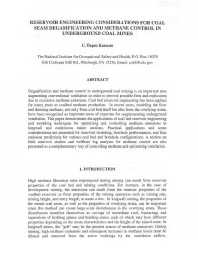Mining Publication: Reservoir Engineering Considerations for Coal Seam Degasification and Methane Control in Underground Mines
Original creation date: November 2009
Degasification and methane control in underground coal mining is an important area augmenting conventional ventilation in order to prevent possible fires and explosions due to excessive methane emissions. Coal bed reservoir engineering has been applied for many years to coalbed methane production. In recent years, modeling the flow and draining methane, not only from coal bed itself but also from the overlying strata, have been recognized as important areas of expertise for supplementing underground ventilation. This paper demonstrates the applications of coal bed reservoir engineering and modeling techniques for optimizing and controlling methane emissions in longwall and continuous miner sections. Practical applications and some considerations are presented for reservoir modeling, borehole performances, and face emission predictions for various coal bed and borehole configurations. A section on field reservoir studies and well bore log analyses for methane control are also presented as a complementary way of controlling methane and optimizing ventilation.
Authors: CÖ Karacan
Conference Paper - November 2009
NIOSHTIC2 Number: 20036227
Proceedings of the Ninth International Mine Ventilation Congress, New Delhi, India, November 10-13, 2009. Panigrahi DC, ed., New Delhi, India: Oxford & IBH Publishing Co. Pvt. Ltd., 2009 Nov; 1:505-516
See Also
- A CART Technique to Adjust Production from Longwall Coal Operations under Ventilation Constraints
- Degasification System Selection for U.S. Longwall Mines Using an Expert Classification System
- Guidelines for the Control and Monitoring of Methane Gas on Continuous Mining Operations
- MCP - Methane Control and Prediction - 2.0
- Methane Diffusion Parameters for Sized Coal Particles: A Measuring Apparatus and Some Preliminary Results
- A Methodology for Determining Gob Permeability Distributions and its Application to Reservoir Modeling of Coal Mine Longwalls
- Modeling and Prediction of Ventilation Methane Emissions of U.S. Longwall Mines Using Supervised Artificial Neural Networks
- Reservoir Modeling-Based Prediction and Optimization of Ventilation Requirements During Development Mining in Underground Coal Mines
- Reservoir Simulation-Based Modeling for Characterizing Longwall Methane Emissions and Gob Gas Venthole Production
- Technology News 465 - Method for Predicting Methane Emissions on Extended Longwall Faces
- Page last reviewed: 9/21/2012
- Page last updated: 9/21/2012
- Content source: National Institute for Occupational Safety and Health, Mining Program


 ShareCompartir
ShareCompartir
